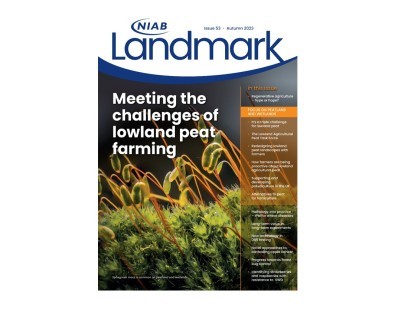26 Oct 2023

Landmark is NIAB's corporate publication, published three times a year, featuring in-depth technical articles on all aspects of NIAB crop research, comment and advice.
Available to all - access the online PDF version of Issue 53 - Autumn 2023, featuring a special on lowland peat farming
NIAB Landmark: Autumn 2023
In this issue:
- Regenerative agriculture - hype or hope? NIAB CEO Mario Caccamo discusses the mainstreaming of regenerative agriculture as major food and drink producers, retailers and NGOs embrace the term as a solution to a more environmentally responsible approach to farming, and how NIAB is preparing for a major research effort focused on delivering the science behind regenerative agriculture.
- Redesigning lowland peat landscapes - NIAB's Dr Elizabeth Stockdale and FenlandSOIL's Megan Hudson summarise how the barriers to rewetting and restoration of lowland peat landscapes are being unlocked by working with farming communities to access and develop local knowledge and data on soils, biodiversity and land-water relationships.
- Paludiculture in the UK, or farming with high water tables, is a system of agriculture for the profitable production of wetland crops under conditions that support the competitive advantage of these crops. While the term ‘paludiculture’ is a recent one, its practice in England goes back generations, and is once again coming to the forefront of UK agriculture.
- NIAB technical manager Ben Tea outlines the alternatives to peat for horticulture, including coir, wood fibre, expanded clay pellets, biochar, perlite and vermiculite, and how the industry has been working towards the transition, including growing media research work carried out by NIAB.
- IPM for wheat diseases - from variety choice to exploiting genetic resistance, in the first of two parts Dr Aoife O'Driscoll summarises the knowledge and expertise from collaborative research projects and independent advice on wheat disease management which is available to UK growers in 2024.
- New tech in DUS testing - NIAB’s Dr Margaret Wallace explains how new technology, such as molecular markers and drone imaging, is being explored for use in crop variety DUS (distinctness, uniformity and stability) testing, which supports Plant Breeder’s Rights and Variety Listing, to improve the decades old process that is hugely labour and data intensive.
- Soils and farming systems specialist David Clarke walks us through the rich resource of long-term agricultural experiments, some over 120 years old, in the UK and globally, that provide vital insights into how modern farming practices are impacting soil health and crop productivity, including TMAF's own Saxmundham site managed by NIAB, here shown in 1978.
- Identifying SWD resistance - since the arrival of spotted wing drosophila in the UK in 2012 NIAB has led industry research into its biology, behaviour and control. NIAB's Adam Whitehouse and Scott Raffle introduces promising new research, funded by Growing Kent & Medway, into variety resistance to the pest in strawberries and raspberries.
- Progress in forest bug control - with the withdrawal of the insecticide chlorpyrifos in 2016, there have been increasing numbers of new insect pests in apple and pear orchards that had previously been controlled, or not been considered a pest for generations. NIAB’s Dr Francis Wamonje and Scott Raffle outline how research is developing new knowledge to improve management of one such pest, the forest bug.
